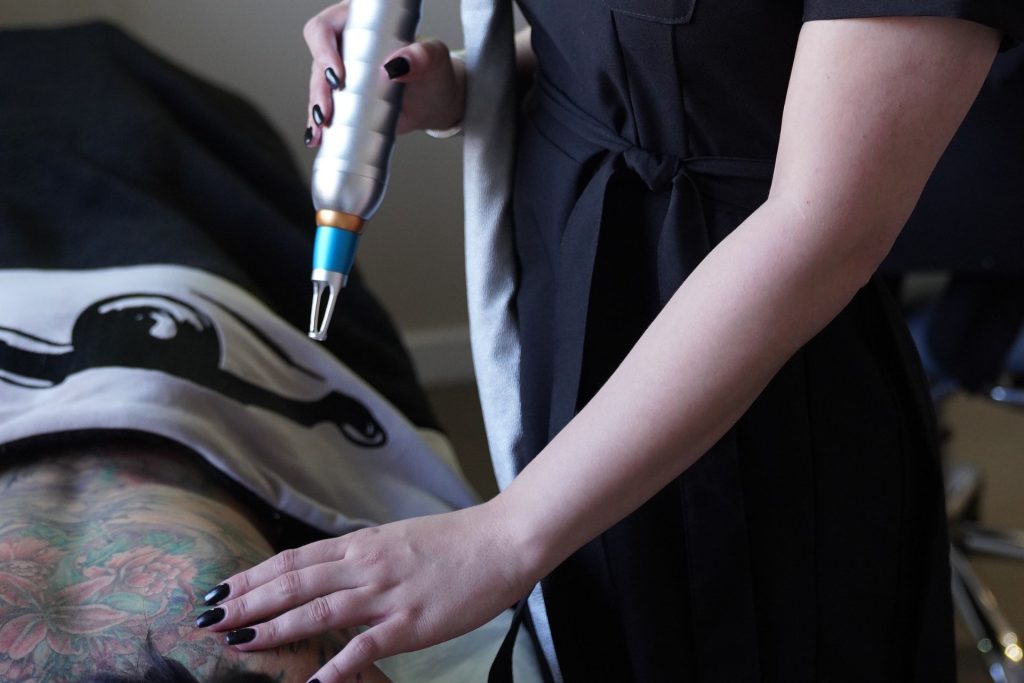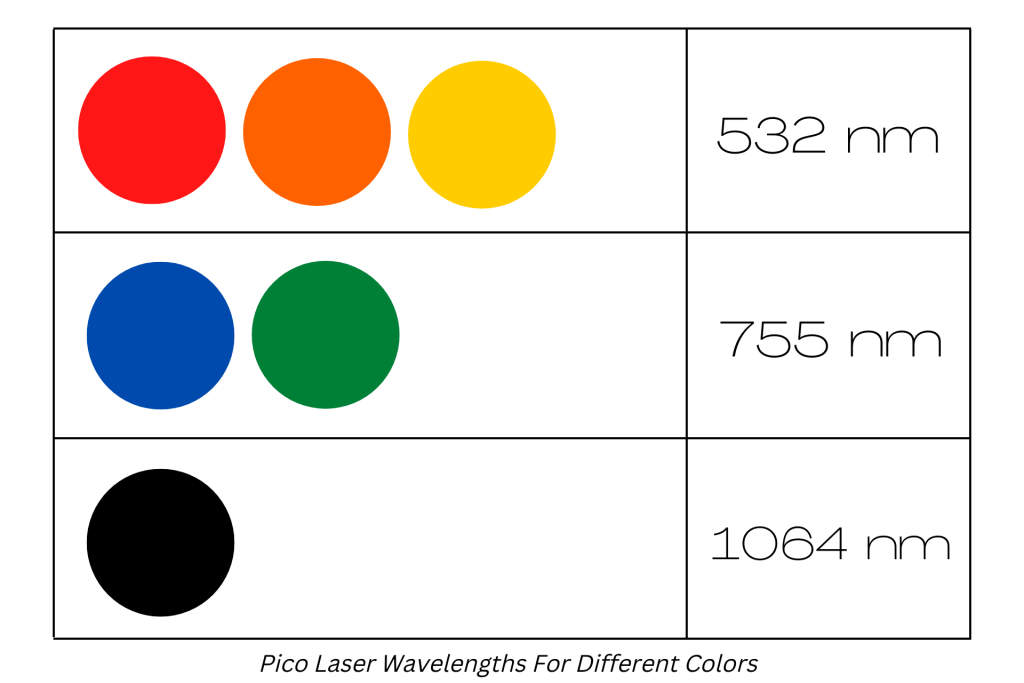
The success and popularity of tattoo removal procedure depends on a number of factors. The first and foremost, is the technology. Laser technology is considered by a wide range of people to be a very safe and secure tattoo removal process unlike other ways like surgery or dermabrasion. Q-switched laser technology (nanosecond lasers) has been the most popular and safest choice for tattoo removal since the 1990s. Nanosecond lasers came to displace many existing tattoo removal procedures, such as dermabrasion, salabrasion, surgery and CO2 laser removal.
However, Picosecond (10-12 seconds) lasers have now emerged to be another very popular choice for tattoo removal due to its wide range of effectiveness and more desirable clearance outcomes. It ensures less pain and risk, faster laser removal results, removal of a wider range of colors, lesser treatment sessions and more effective tattoo clearance. For an in-depth comparison of the two, read the article Nano vs Pico Laser Tattoo Removal.
More important than choosing between the two technologies, is to keep in mind that not every laser device was designed to remove tattoos, and choosing a wrong laser device can do more harm than good. Another factor that needs consideration, is the laser setting. The laser technician or medical practitioner must take notice of the laser’s wavelength (determined by the colors of the tattoo ink), pulse rate (faster the pulse rate, more effective is the breakdown of ink pigments) and spot-size (determined by ink’s depth). All of these factors are important to target ink pigments while trying to reduce damage to the surrounding skin.
How is Pico Laser Effective For Tattoo Removal?
Picosecond laser uses pulse durations of less than 1 nanosecond (300-900 ps), which causes photoacoustic breakdown rather than photothermal damage of ink particles. This results in clearance of the ink quicker and better and minimizes risk and damage to the skin surrounding the targeted area.
The Pico technology’s high specifications help increase the speed at which the tattoo ink pigments break, in turn reducing the number of treatment sessions.
How Does Pico Laser Work?
A picosecond is a million times shorter than a second. These pulses generate two effects:
- Sudden increase in temperature in the tattoo pigment – the picosecond laser produces a highly concentrated energy delivery. In that way the temperature increases rapidly and the ink pigments break into tiny particles, which are discarded by the body easily.
- Higher effectiveness on smaller ink particles.
Picosecond Wavelengths For Different Colors
The process through which laser tattoo removal works is called photothermolysis. A specific wavelength of laser light is necessary in order to produce heat and break the ink particles of the tattoo into even smaller particles for the body’s immunity system to eradicate.
The following wavelength measurements have been found effective for different colors:
- Picosecond at 532 nm for rapid removal of yellow, orange and red tattoo ink.
- Picosecond at 755 nm for blue and green color tattoo removal.
- Picosecond at 1064 nm for black or dark colored tattoo ink and removal in darker skin type.
Why Choose A Picosecond Laser?
Laser technology is evidently the most popular tattoo removal process. It ensures safer ink removal compared to other tattoo removal procedures.
The picosecond selectively breaks down targeted ink pigments without damaging healthy skin tissue cells and surrounding skin. This laser technology not only requires lesser treatment sessions compared to nano laser technology but also results in reduced post-treatment downtime (like scarring, hyperpigmentation, etc.)
Cost Of Pico Laser Treatment
Like all laser removal technology, cost of Pico laser treatment depends on a few factors including the number of sessions, colors of the ink, age of the tattoo, and complexity of the design. Due to Pico laser being at the higher end of technology, a Pico laser treatment is on the costlier side.
Preparing Skin For Pico Laser Treatment
These protocols might help with preparing the skin for a Pico laser treatment and maximizing its effectiveness –
- Minimizing sun exposure just prior to the Pico laser treatment. Many specialists advise using sunscreen on the inked region to protect the area from the sun’s rays.
- The inked region needs to be totally clean. It is always advisable to not apply any kind of oils, lotions, or creams on the tattooed region.
- Removing all kinds of makeup.
Pico Laser Tattoo Removal After Care
The aftercare routine regulates the healing process after the Pico laser treatment session.
5 important aftercare tips are listed below:
- Applying prescribed soothing cream – Helps in calming down the tissues that are to be healed after the laser procedure.
- Sun protection – Using a chemical-free SPF 30+ sunscreen for at least 3 days after the laser treatment can protect from harsh sun rays which might damage delicate post-treatment tissues.
- No makeup – Using cosmetics which contain chemicals or artificial fragrances causes irritation to the delicate post-treatment skin causing pore blockage and other complications.
- Hydration – Staying hydrated promotes in better healing process.
- Cleansing – Cleaning skin with cold water and chemical-free, non-soapy face/body wash regularly helps in removing accumulated dirt and germs.
What Are The Benefits of Pico Laser Tattoo Removal?
Pico lasers offer some benefits which sets it apart from other tattoo removal technologies –
- Pico laser is highly targeted, which means risk of damage is minimized.
- Pico laser treatment may experience aftereffects (redness, swelling) for relatively lesser amount of time.
- Pico laser treatment has less to no side effects. When performed correctly, it does not produce any damaged skin or uncomfortable skin conditions.
- Pico laser treatment is not very painful. Some may experience temporary discomfort, but it is bearable enough.
- Pico laser treatment takes fewer sessions to achieve desirable results.
- Pico laser treatment sessions are very fast.
Side Effects/Risks of Pico Laser
Picosecond laser technology is well received and tolerated by a wide range of people who want their tattoos to be removed. However, people in some cases might still face some side effects. Potential side effects include – oedema, crusting, pinpoint bleeding, blistering, scarring, hyper/hypopigmentation, erythema, etc.
Additional Advantages of Pico Laser
Pico laser technique functions quick and effectively. It is not just helpful for removing tattoos, but can be used for the following reasons:
- Skin Rejuvenation: Pico laser technology provides effective skin resurfacing and smoothening treatments, working against fine lines, dark circles and wrinkles, resulting in a more youthful appearance. Since collagen production is induced in deeper dermis layers, the skin looks rejuvenated.
- Treating Acne Scars: Pico laser is effective towards lightning acne or pimple spots. It has been a popular choice for many people as acne continues to be a very common skin issue. Acne scars are very difficult to remove, and are therefore hyperpigmented and resistant to many different treatments. The pico laser technique breaks down the pigments in the targeted dark spots/areas resulting in skin texture without dark patches or spots.
- Treating Melasma: Extreme sun exposures cause hyperpigmentation to skin, creating dark patches or spots. Sometimes, it also results in common skin condition called melasma. It occurs when patches of discoloration develop on the face, shoulders, forearms or neck due to extensive hours under the sun without proper protection. However, sun exposure isn’t the only reason for melasma. Pregnancy, birth control pills, hormone replacement may also result in melasma. Pico laser treatment is considered to be an effective method to treat this condition.




